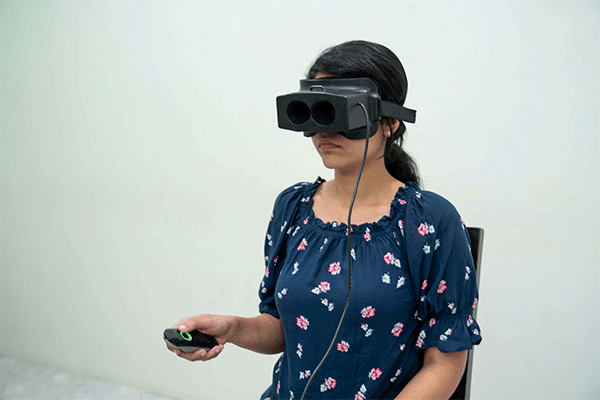Due to our visual, vestibular, and somatosensory systems, we have a generally good ability to perceive verticality. However, in the case of an injury or damage to the otolith organs or to the nerve responsible for transferring data from the inner ear to the brain.
When the nerve is unable to send the signals, it can cause the brain to misinterpret information and hamper the patient’s ability to perceive the visual vertical or the vertical line.
Vestibular disorders are one of the most common causes of deviation in the subjective visual vertical for most patients.
What is the Subjective Visual Vertical Test?
A subjective visual vertical test is used to asses a patient’s perception of verticality. It is a diagnostic test of the inner ear that is used to determine if there is an abnormal test present in the patient’s perception that may cause dizziness or vertigo.
It is important to under that an SVV test is subjective and cannot be used to directly diagnose problems like Meniere’s disease, vestibular migraine, or any other central nervous system pathologies.
SVV Vertigo Test is used to check the functioning of the utricle which is one of the two otolith organs that are located in the vertebrate inner ear.
Let’s take a look at the technique and usage when it comes to the SVV Vertigo Test.
SVV diagnosis, technique, and usage:
A subjective visual vertical diagnosis is used keeping the following objectives in mind:
— To diagnose vestibular disorders.
— To assess the effectiveness of subjective visual vertical treatment in patients who are suffering from vertigo.
— To asses chronic dizziness and other disorders relating to the otolith.
— As a way to differentiate between peripheral and central vestibular disorders.
There are a number of ways when it comes to conducting the SVV test. Here are some ways by which a Subjective Visual Vertical diagnosis is obtained:
— One of the most common ways used to test SVV in subjective visual vertical treatment involves the patient sitting in a dark room and adjusting a laser projection line using a remote to his or her perceived vertical or horizontal position. It can also include a dynamic aspect too such as a rotary chair.
— Another method of testing SVV is known as the bucket test. In this test, a bucket is placed over the patient’s head until a line at the bottom of the bucket is perceived to be vertical by the patient.
— Lastly, most modern SVV diagnosis tests involve the use of a high-tech Google and hand-held remote that is used to ascertain the subjective visual vertical of the patient.
NueroEquilibrium SVV vertigo test:
We provide systems for the comprehensive management of vertigo and balance disorders using breakthrough innovations. We provided a patented, advanced system of diagnosing the subjective vertical visual in patients.
Our product to test SVV is a tubular vision goggle with 9 axis IMU which provides real-time data analysis. It is a fully integrated and computerized process and we have ensured that it is extremely simple to use with no moving parts involved in the product.
Our SVV diagnosis tools can be used to perform a number of tests such as:
— Static SVV, head vertical
— Static SVV, head inclined at 30 degrees
— Dynamic moving background, head vertical
Types of Subjective Vertical
Subjective Visual Vertical is considered to be one of the three components of subjective vertical. The other two components are Subjective Postural Vertical and Subjective Haptic Vertical. Let’s take a look at the components a bit more in detail:
— Subjective Visual Vertical, as mentioned above in this blog, refers to the process of a patient adjusting a visible line in a room with complete darkness. Patients suffering from a vestibular disorder can experience the line being titled at 10 degrees.
— Subjective Postural Vertical refers to the position of the body or head of the patient with respect to the true vertical. One of the most common causes of an improper subjective postural vertical is cerebral lesions.
— Subjective Haptic Vertical is not usually affected by a vestibular disorder.
Modern Subjective Visual Vertical Tests
These days’ subjective visual vertical tests have become computerized and use the latest technology to provide the best diagnosis and treatment functions in patients. We believe in using the latest technology to provide the best treatment experience for patients suffering from vestibular disorders.
Conclusion
SVV tests are used to diagnose vestibular disorders that can cause problems in the perception of the visual vertical in patients. It is used to determine the exact causes of the patient’s problem when it comes to patients suffering from a faulty perception of the visual vertical.






